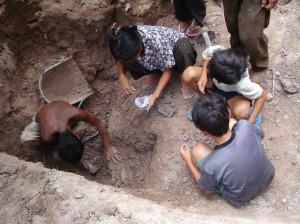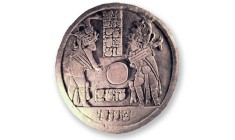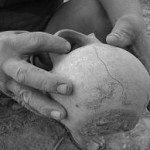Subsistence Digging
Authors: Donna Yates & Neil Brodie
Last Modified: 17 Aug 2012

The term ‘subsistence digger’ is used to refer to an individual who engages in the illicit excavation of archaeological sites for saleable cultural objects due to extreme poverty (Hollowell 2006; Matsuda 1998, 2005). It is derived from the idea of subsistence farming and implies that the person engaging in the activity has few other economic opportunities; that they are looting for survival, not profit.
The genealogy of the term ‘subsistence digging’ can be traced back to Dwight Heath’s (1973) sympathetic study of illicit excavation in Costa Rica. He struggled to find an equitable translation of the Quechua/Spanish huaquero, and preferred ‘commercial archaeologist’ to ‘grave-robber’. Frederick Lange (1976) revisited Costa Rica in 1976, and referred to ‘subsistence archaeologists’. In 1993, David Staley reported on what he termed the ‘subsistence diggers’ of St Lawrence Island, defining a ‘subsistence digger’ as ‘a person who uses the proceeds from artifacts sales to support his or her traditional subsistence lifestyle’ (Staley 1993: 348), suggesting at the time that sales of excavated artifacts constituted 13 percent of average household income (Staley 1993: 349).
References
Heath, D.B. (1973), ‘Economic Aspects of Commercial Archaeology in Costa Rica’, American Antiquity, 38, 259-265.
Hollowell, Julie (2006), ‘Moral arguments on subsistence digging’, in Christopher Scarre and Geoffrey Scarre (eds.), The Ethics of Archaeology: Philosophical Perspectives on the Practice of Archaeology (Cambridge: Cambridge University Press), 69-93.
Lange, F.W. (1976), ‘Costa Rica and the “Subsistence Archaeologist’, Current Anthropology, 17, 305-307.
Matsuda, David (1998), ‘The Ethics of Archaeology, Subsistence Digging, and Artifact Looting in Latin America: Point and Muted Counterpoint’, International Journal of Cultural Property, 7 (1), 87-97.
— (2005), ‘Subsistence Diggers’, in Karen Fitz Gibbons (ed.), Who Owns the Past? Cultural Policy, Cultural Property, and the Law (New Brunswick: Rutgers University Press), 225-65.
Staley, D.P. (1993), ‘St Lawrence Island’s Subsistence Diggers: a New Perspective on Human Effects on Archaeological Sites’, Journal of Field Archaeology 20, 347-355.


